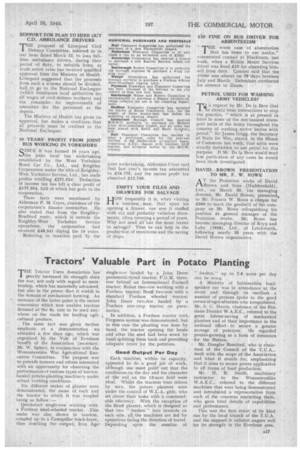Tractors' Valuable Part in Potato Planting
Page 19

If you've noticed an error in this article please click here to report it so we can fix it.
THE Tractor Users Association has greatly increased its strength since the war, not only with regard to membership, which has materially advanced, but also in the power, that it wields in the domain of mechanized farming. An
• instance of the latter point is the recent concession which now enables tractors licensed at the 5s. rate to be used anywhere on the roads for hauling agricultural produce.
The same fact was given further emphasis at a demonstration we. attended a few days ago, which was organized by .the Vale of 'Evesham brann of the Association (secretary,• Mr. W. Spiers), in conjunction with the Worcestershire War Agricultural Executive Committee. The purpose was to provide farmers and others interested with an opportunity for observing the performances of various types of tractorhauled potato-planting machinery under actual working conditions.
Six different makes of planter were demonstrated, the name of each and the tractor to which it was eoupled being as follow:— •
Quickstart single-row working with a Fordson steel-wheeled tractor. This make was also shown in tandem, coupled up to a -Caterpillar track-layer, thus doubling the output; Iron Age.
single-row hauled by a John Deere pneumatic-tyred tractor; P.G.M. threerow behind an International Farmall tractor; Robot two-row working with a Fordson tractor; Brag two-row with a standard Fordson wheeled tractor; John Deere two-row hauled by a Fordson row-crop tractor on pneumatics.
In addition, a Fordson tractor with Ferguson system was demonstrated, but in this case the planting was done by hand, the tractor opening, the bouts and after the seed had been sown by hand splitting them back and providing adequate cover for the potatoes.
Good Output Per Day s
Each machine, within its capacity, appeared to do a good job of work, although one must point out that the conditions-on the day and the character of the soil on the 12-acre field were ideal. Whilst the tractors were driven by men, the potato planters were under the control of W.L.A. girls, who set about their tasks with A commendable efficiency. With the exception of the Bruff planter, which is designed so that two " feeders " face inwards on each side, all the machines are fed by operatives fading ng the direction of travel. Depending upon the number of -" feeders," up to 7-8 acres per day can be sown.
A Ministry of Information loudspeaker car was in attendance at the event and through its 'medium a number of persons spoke to the good crowd of agriculturists who foregathered. Mr. S. G. Harris, chairman of the Pershore District W.A.E.C., referred to the great labour-saving of mechanical planters and of their importance in the national effort • to secure a greater acreage of potatoes. He regarded potato-growing as a form of insurance for the Nation.
Mr. Douglas Bomford, who is chairman of the Council of the T.U.A., dealt with the scope of the Association and what it stands for, emphasizing that it aims to secure power application to all forms of food production.
Mr. H. R. Smith, machinery instructor to the Worcestershire W.A.E.C., referred to the different machines that were being demonstrated and introduced a representative from each of the concerns marketing them, who gave brief details of capabilities and performance.
This was the first event of its kind run by the local branch of the T.U.A. and the supportit enlisted augurs well for its strength in the Evesham area.




















































